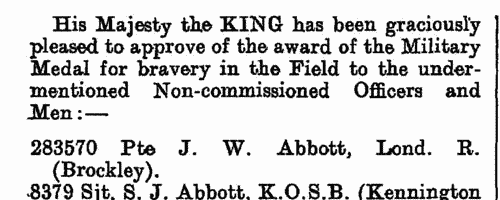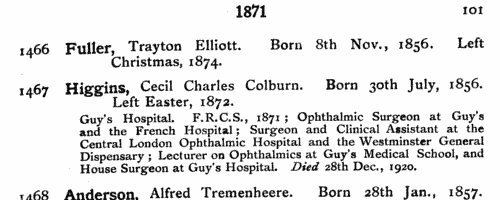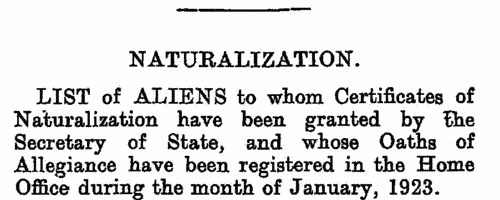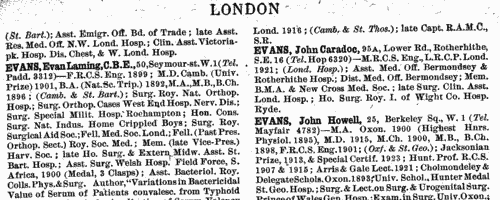Add this eBook to your basket to receive access to all 89 records. Our indexes include entries for the spelling soutar. In the period you have requested, we have the following 89 records (displaying 61 to 70): These sample scans are from the original record. You will get scans of the full pages or articles where the surname you searched for has been found. Your web browser may prevent the sample windows from opening; in this case please change your browser settings to allow pop-up windows from this site.  Queen's South Africa Medal: Royal Field Artillery: 38th Battery
(1901-1905) Queen's South Africa Medal: Royal Field Artillery: 38th Battery
(1901-1905)
The nominal roll for the Queen Victoria's South Africa Medal - awarded (after her death, in the event) to all who had served honourably in the various campaigns in the Boer War - was compiled from these returns from the individual units. Two sets of form were completed. The main one, as in the sample scan, dates from 1901 and gives regimental number, rank, and full name (surname first), followed by a series of columns relating to different actions - Belmont, Modder River, Paardeberg, Dreifontein, Wepener, Johannesburg, Diamond Hill, Belfast, Wittebergen, Defence of Kimberley, Relief of Kimberley, Defence of Mafeking, Relief of Mafeking, Cape Colony, Orange Free State, Transvaal, Rhodesia, Talana, Elandslaagte, Tugela Heights, Defence of Ladysmith, Relief of Ladysmith, Laing's Nek, and Natal; each entitled the man to a separate clasp to the medal, and a tick or a Yes in the appropriate column indicates the man's actual physical presence in that battle. A final column for remarks is important in those cases where the man was no longer in the unit, by removal, death or desertion. The second form that sometimes occurs was returned in 1905, and covers men entitled to the Second South African War Medal and Clasps. It lists men by number, rank and name, checks whether they had claimed the Queen's South Africa Medal, and then enquires as to their suitability as to three Colony Clasps, which could be awarded for service in the Cape, Orange Free, or Transvaal; whether entitled to Date Clasps (South Africa 1901 and South Africa 1902); whether also entitled to the King's South Africa Medal; any other corps in which served in South Africa; and remarks (such as becoming non-effective, forfeiture, &c.) WO 100/141 | Sample scan, click to enlarge

| Certificate of Efficiency in Psychological Medicine
(1906)
The Journal of Mental Science for 1906 included this list of those who had passed the Examination for the Certificate of Efficiency in Psychological Medicine, entitling them to append M.P.C. (Med.-Psych. Certif.) to their names. Full names are given, surname first.
| Sample scan, click to enlarge

| Members of the Medico-Psychological Association
(1906)
The Journal of Mental Science for 1906 included this list of members of the Medico-Psychological Association of Great Britain and Ireland, giving year of joining, full name (surname first), qualifications, and address: an asterisk indicates a member who joined between 1841 and 1855. | Sample scan, click to enlarge

| Military Medal
(1918)
King George V approved the award of the Military Medal for bravery in the Field to these non-commissioned officers and men 6 August 1918. | Sample scan, click to enlarge

| Chemists and Druggists
(1919)
The official register printed under the direction of the Pharmaceutical Society of Great Britain pursuant to the act of 31 & 32 Victoriae, cap. 121 (An Act to Regulate the Sale of Poisons, and Alter and Amend the Pharmacy Act, 1852) comprised two sections:
1.The Register of Pharmaceutical Chemists, giving date of registration, number of examination certificate, full name (surname first, in capitals), and residence;
2. The Register of Chemists and Druggists, giving date of registration, full name (surname first, in capitals), residence, number of examination certificate (major or minor), and qualification. | Sample scan, click to enlarge

| Boys entering Brighton College
(1921)
This edition of the Brighton College Register was published in 1922. The plan of the publication was to list boys by year or, later, term of entry. Each name is assigned a sequential number, 5000 boys, in all, being recorded. Full name is given (surname first, in bold); date of birth; year of leaving; and then (wherever the compiler had such information) a short biography, ending with date of death, where known. Of course, for the boys entering the school in the last few years up to 1922, the details are little more than name and date of birth. | Sample scan, click to enlarge

| Naturalizations
(1923)
The Home Office issued monthly lists of aliens to whom Certificates of Naturalization had been granted by the Secretary of State and whose oaths of allegiance had been registered in the Home Office. These notices, from January to December 1923, refer to naturalizations from December 1922 to November 1923. The lists give full name (surname first) with any aliases; country of origin; occupation; full postal address; date of taking the oath. A dagger indicates re-admission to British nationality; an asterisk that the person had served in H.M.'s Forces. | Sample scan, click to enlarge

| Medical Practitioners in London
(1926)
The Medical Directory was split into several sections. The London section covered all medical practitioners resident within the London postal district. Each year a schedule was sent to each doctor to be returned to the publishers, so as to keep the directory up to date. In the directory the doctor's name is given first, in bold, surname first, in capitals; then current address. Next are the qualifications; the italic abbreviations in parentheses following the qualifications indicate the medical school at which they were gained. Then there is a list of posts and honours within the profession, starting with those then current; previous posts are preceded by the word 'late'. Finally, brief details are given of any publications. | Sample scan, click to enlarge

| Medical Practitioners in Scotland
(1926)
The Medical Directory was split into several sections. The Scottish section covered all medical practitioners resident within Scotland. Each year a schedule was sent to each doctor to be returned to the publishers, so as to keep the directory up to date. In the directory the doctor's name is given first, in bold, surname first, in capitals; then current address. Next are the qualifications; the italic abbreviations in parentheses following the qualifications indicate the medical school at which they were gained. Then there is a list of posts and honours within the profession, starting with those then current; previous posts are preceded by the word 'late'. Finally, brief details are given of any publications. | Sample scan, click to enlarge

| Medical Practitioners in the Provinces
(1926)
The Medical Directory was split into several sections. The Provinces section covered all medical practitioners resident in England outside the London postal district (except those in Monmouthsire, who were listed under Wales). Each year a schedule was sent to each doctor to be returned to the publishers, so as to keep the directory up to date. In the directory the doctor's name is given first, in bold, surname first, in capitals; then current address. Next are the qualifications; the italic abbreviations in parentheses following the qualifications indicate the medical school at which they were gained. Then there is a list of posts and honours within the profession, starting with those then current; previous posts are preceded by the word 'late'. Finally, brief details are given of any publications. | Sample scan, click to enlarge

|
Research your ancestry, family history, genealogy and one-name study by direct access to original records and archives indexed by surname.
|












